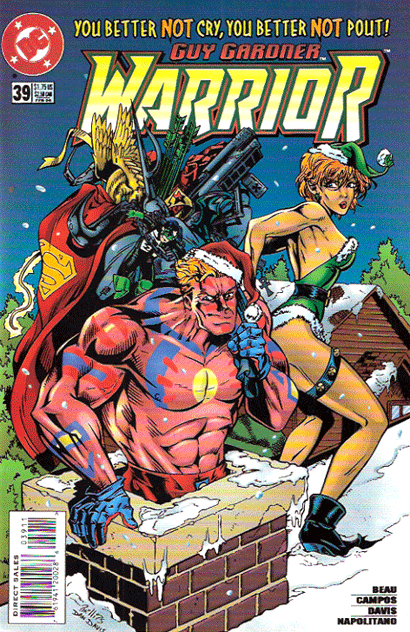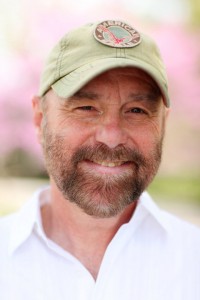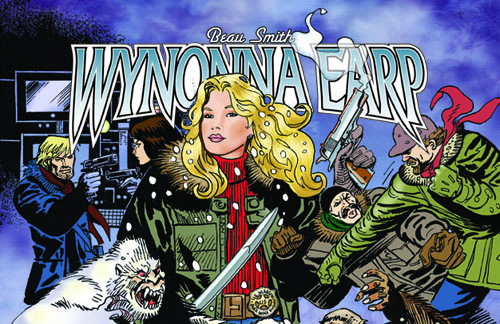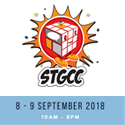Fists of Witty: An Interview with Beau Smith
There are 200 violent psychopaths on the loose, and only one man can boot them from this mortal coil.
For nearly 30 years, comic-book writer Beau Smith has helped define what it is to be a man. No, not just in the physical sense. Smith’s characters are never meatheads. From the relentlessly protective ex-Secret Service agent in Cobb to the heroic sci-fi tough guy Pendelton Spurr in Parts Unknown, Smith’s protagonists are a throwback to the extraordinary gentlemen of pulp fiction and Golden and Silver Age comics, everybody from Doc Savage to Nick Fury. They aren’t always men, either; one of Smith’s most popular creations is Wynonna Earp, stainless steel U.S. Marshal that no one would dare piss off.
Smith’s comics, whether his creator-owned books or ones he’s written for DC and other companies, read like a hybrid of influences. The action is always quickly paced, steeped in the loud, brutal fisticuffs and flying bullets of Sam Peckinpah but elevated by the good-natured buddy humor of the Lethal Weapon films of the ‘80s. His characters are strong but given loveable hearts, something that Stan Lee mastered in the dawn of Marvel Comics. Aside from that, Smith filters his stories with a lifetime of genre affection, wonderfully obvious nods to Westerns, ‘50s B-movies, ‘70s drive-in cinema, creature features, and even E.C. horror comics.
One gets the sense that Smith is reliving his childhood through his tales, which ends up taking his readers along with blissful nostalgia. Smith’s latest project, 200 People to Kill for Dark Horse Comics, sounds like serious stuff with a title that Quentin Tarantino would be so envious of. However, knowing Smith, one way or another he will make it fun, which is what this gloom-saturated industry needs more of today.
FLIPGEEKS: You started off writing letters to comic books. How did you make the transition from comics fan to comics pro?
BEAU SMITH: You’re right, I started out as what we used to call a “Letterhack.” I had probably 200 letters printed in various comic books from 1978-1986. You’ve gotta remember, this was before the Internet so all these letters of comment were sent via the U.S. Mail. I would buy my week’s supply of comic books, and as I finished one, I would write a letter of comment to the editor about that particular issue. I guess that would put me at sending out 8-10 letters a week. Living in Huntington, West Virginia, that put me just out of walking reach of New York City, where most of the comic book publishers dwelled.It was my early way of networking as well as marketing myself to the editors.
I tried to make my letters as entertaining and constructive as possible. I wanted to set myself a part as much as I could from the other letters that they got in the mail. I studied what the other prolific letter writers did, and I tried my best to be a little better, or at least different. I even signed my full name, Stephen Scott Beau Smith. The editors would grin when I would finally meet them at a convention and say, “Hey, you’re the guy with four names!” It worked for me. After a while, the editors would send me advance copies of comic books scripts, Xeroxes, and ask me if I’d write a letter of comment for it so they could have letters in the first issue. They also asked me if I ever thought about writing comics; from there, the door was open. I sold my first story to Pacific Comics out of California, thanks to David Scroggy and Bill Schanes. The company stopped publishing before the story could ever go to print, but it was a start. I also had a couple of articles on the history of “Letterhacks Turned Pro” in the comics magazine, Amazing Heroes from Fantagraphics. The article was illustrated by Don Rosa of Donald Duck fame. (Thanks to Dave Olbrich.) So my first paid work was a $14 check from Gary Groth. I never cashed it and still have it somewhere here at the ranch.
It was at Chicago Con in the early ‘80s that I met fellow West Virginian comic book creator Tim Truman. We hit it off and became instant, lifelong friends. Through Tim I also met my other 4 Winds amigos, Chuck Dixon, Flint Henry, Gary Kwapisz, Tom Lyle, Graham Nolan, John K. Snyder III, Tim Harkins, and John Ostrander. Tim knew that I was a sales and marketing professional as well as an aspiring writer. He told me that Eclipse Comics was looking for someone to head up their sales and promotions so he was kind enough to hook me up with Dean Mullaney, the publisher at Eclipse. Dean and I met at the American Booksellers Association in Washington, D.C., and soon after that, I was their sales and marketing guy. Tim also allowed me to write Beau LaDuke back up stories in his Scout comic. He and Chuck Dixon were kind enough with their time and knowledge to also help me learn the writing ropes of comics. The list of folks I owe is almost endless, but it starts with these guys. Here it is, 27 years later, and comics still haven’t found a way to kick me out. I’m the Director of Marketing for The Library Of American Comics (run by Dean Mullaney, talk about full circle), and I’m writing more comics than ever.
 FG: You are perhaps best known for your ‘90s run on Guy Gardner. What was it about the character that appealed to you?
FG: You are perhaps best known for your ‘90s run on Guy Gardner. What was it about the character that appealed to you?
Smith: The thing that appealed to me the most was that Guy Gardner always struck me as one of those characters that had a world of potential, but the surface was only scratched. Keith Giffen, J.M. DeMatteis, and the art of Kevin Macguire really gave Guy a distinct personality, one that hooked the readers and also made Guy stand out from every other superhero at the time. They were able to add some humor to not only Guy, but also the rest of the members of Justice League International, a shot in the arm if there ever was one. (And needed today in the DCU). In the early ‘90s Guy had his own book and was written by my friend, Chuck Dixon. Chuck was able to solidify Guy’s personality by making him count and to move him forward so that he wouldn’t be the “punch line” to endless Batman jokes. Chuck was leaving the book and was kind enough to suggest me as the “take over” writer to editors Kevin Dooley and Eddie Berganza (Guy Gardner Warrior #20). I knew Kevin from my letterhacking days as well as Amazing Heroes. Eddie and I first met when he was an editor for Starlog Magazine. I had also done my first DC Comics worked for Kevin Dooley in Green Lantern Quarterly, where I created one of the first “Green Lanterns,” Probert – The Bad One.
I wanted to not only continue to move Guy forward like Chuck had begun, I also wanted to add much needed layers to the character as well as establish a supporting cast for him. I wanted Guy to be the character any reader could relate to. I’ve gotta say that during this time of Guy Gardner, his sales were at what DC Comics considered low, 40,000. With current pitiful comic book sales, these numbers would put Guy Gardner in the Top 10. I came in during the deconstruction of the Green Lantern Corps, Guy Gardner #20, where DC told me that they were doing away with all the rings and lanterns. I was fine with that; I always though there was too many anyway. So I was ripe for tearing something down and building something new. I always believed that Guy was a hero first, above and beyond anything else. I was firm in the fact that Guy would be a hero with or without a ring, sword, gun, or any other tool or prop. He didn’t need a hero’s cape; he had a hero’s heart.
FG: Until you began writing Guy Gardner, he was mainly utilized as a comedic punch line in the revamped Justice League of the ‘80s. How did you convince DC to allow you to show a different side to the character?
Smith: There really wasn’t much convincing. As I mentioned, DC was tearing down the GLC, sales on the book were low, and so I was kinda flying under the radar and was free to really change things up. My editor, Eddie Berganza, and I really enjoyed the freedom to do some fun stuff and break away from the standard DCU “event” mode. Except for royalties, I’d love to always come in on a low-selling book and obscure character; the freedom is worth it. I was all set to not give Guy any super powers at all and make him somewhat of a globetrotting adventurer with a Doc Savage-like supporting cast, Buck Wargo and The Monster Hunters. DC had different ideas so we had to end up giving him some powers. Not too bad of a compromise, until the sales of the book went up and everybody wanted to borrow Guy; that’s when he began morphing chainsaws and egg beaters from his hands. Not what I signed up for.
FG: What writers had the biggest influence on you and what did you learn from them?
Smith: In comic books, Stan Lee for his sense of how to write a compelling story, introduce new characters, and market those characters and Marvel Comics by marketing himself. Robert Kanigher for his technical skills. Chuck Dixon and Tim Truman for the way they can see comics with a cinematic eye and make static pictures move. Walt Simonson and Mike Baron for teaching me how to outline and write a pitch, which I still think is the hardest thing about comic-book writing. Outside of comics, Elmore Leonard, he was a master at great stories made by the personalities of the characters and what came out of their mouths. Brilliant dialogue that made even the smallest character seem like the star. Clair Huffaker, nobody could write the tale of friendship and dignity like he could. Don Winslow: His work has kept me stoked to be able to write characters that let their words show action, and their actions tell the story. Larry McMurtry, because he proved you can write an epic and still make the characters seem like you’re in a small room with them. Recently, Christopher Farnsworth. The guy is amazing; he makes everything he does feel like he has written it personally for me. His books are filled with things that I find myself saying, “I wish I had written that!”
FG: You’ve never written for Marvel. Was that a conscious choice or simply because you haven’t been given the opportunity to do so?
Smith: Technically, I kinda have written for Marvel. I wrote the Wolverine/Shi one-shot that my amigo Billy Tucci drew. It was a Marvel/Crusade Fine Arts crossover, but I have never written anything for Marvel from a pitch of mine or a request from them. I’ve written written for most every major and minor publisher in comics, but Marvel is still like the last piece of the puzzle for me. It’s funny; Marvel Comics are the ones that truly hooked me into comics, back in the 1960’s when I was a kid, and yet, they are the only one that I’ve never had the chance to write for.I probably know the Marvel characters better than any others, and have loads of ideas for them, but that chance has yet to appear on my desk yet. I hope to write for them before I shuffle off this mortal coil, or before one of my enemies catches me while I’m sleeping. In the ‘80s and ‘90s, I was told by Marvel that they would like to hire me from my pitches, but at the time I was working for Eclipse Comics and Image Comics on the business end so they felt like that was a conflict of interests. It didn’t stop DC Comics and they prospered from my marketing and promotions end, but I’m a freelancer these days, so maybe my Marvel opportunity will come.
FG: Like other veteran comic-book creators such as Chuck Dixon and John Byrne, most of your work today is with independent publishers. You have a new book wonderfully titled 200 People to Kill. What is it about and when will it be published?
Smith: Independent publishing has been very good to me over the years; it’s how I started in comics and where my creator-owned series flourish. My latest creator-owned series is 200 People To Kill. It will be published at Dark Horse Comics as a four-part series and should be out in stores later this year. It’s a turn of the century Western that takes place about 100 years ago along the border of Mexico. It’s a story that I’ve been working on for the last 10 years and finally had the time to hone it sharp and focus time on it.
Originally it was to be drawn by my friend, Eduardo Barreto, but Eduardo passed away a couple of years ago, and I stepped aside with the project for a while not knowing if I would even want to do it without Eduardo. Eduardo and I shared the same mind set on Westerns and I knew it would be tough to do the story without him. God stepped in and blessed me with the talents of another long time friend and co-worker, Enrique Villagran. Enrique and I have worked together on many projects since the ‘80s such as Beau LaDuke, Probert – The Bad One, and of course, Wynonna Earp. Like Eduardo, Enrique knows the Old West and how to present it. 200 People To Kill finds Anderson Nodeen, a former Rough Rider for Teddy Roosevelt, and lawman-turned solider of fortune, hired by a ruthless, radical, U.S.-educated revolutionary named Rojas to be his weapons master for his vicious army of 200 of the most violent psychopaths the west has ever known. The catch is that Nodeen has his own agenda and there are a few twists and turns other than the obvious one that the knives in the back make. Without giving anything away, at one point, Nodeen finds himself having to go from one end of the captured Mexican town to the other to complete his agenda, and the only thing standing in his way are the 200 psychopaths. Makes for an interesting stroll down the dusty street.
FG: Your creation Wynonna Earp is one of the toughest women in comic books. Like Chuck Dixon, you’re recognized for some of the most testosterone-fueled comics of all time but you write women extremely well. What was the inspiration behind Wynonna?
Smith: Thank you for the kind words. As far as inspiration, it’s been pretty well documented that I’m an Old West historian of sorts. My personal library on the Old West would rival any that you might want to compare. I’ve always had a fascination with the Earp family and the political climate that ruled the West from 1870 to 1920. I wanted to tie in a lot of what I had researched and shade it with fiction to give Wynonna Earp not only a deep family history, but to cross over the Old West with another fascination of mine, Cryptology and the paranormal. So I made Wynonna a U.S. Marshal from the Black Badge Division. The Black Badge Division is covert, and like other U.S. Marshals, they hunt down fugitives, only in the case of the Black Badge Division, they hunt down paranormal fugitives. The paranormal has crime, just like the normal world, only just a bit more dangerous. It’s filled with immortals, The Vampire Nation, werewolves, gremlins, spell casters, and even disgruntled, zombie mailmen led by The Post Monster General. The list of Cryptid criminals goes on and on, and it’s up to Wynonna Earp to bag ‘em and tag ‘em. I feel with Wynonna Earp, you’ve got something for every reader.
FG: What are you feelings on DC/Warner’s inability to produce a Wonder Woman film?
Smith: It’s pretty simple. Whoever can figure out what’s on Wonder Woman’s iPod will be able to make the iconic Amazon work on the screen as well as in the comics. I truly feel the problem with making Wonder Woman work is that no one has ever found her character and made it not only work, but make it likeable as well. Everyone thinks they know Wonder Woman, but they don’t. They know the name and the symbol, but that’s where it stops. They need to simplify her character, not her powers and history; that’s all fine and workable, but if you don’t know or like the character, then all the powers and acres of Paradise Island aren’t going to matter a single bit. Until someone (Me) can make Wonder Woman someone you know, she will forever be and empty icon and not a fully realized person. (Fictional, of course.)
FG: Any plans for another Cobb series?
Smith: Yup! Always have had more planned and written out. The surface has just been grazed. I have an “Origin” story worked out as well as the next step from Off The Leash called On The Border where Cobb takes on the Mexican cartels. I may even have to do the rest of Cobb as novels; we’ll see.
FG: You’re a columnist as well, and your film, TV, and comic-book recommendations have been solid gold. What should be watching and reading right now that we might not be?
Smith: I try my best to make sure some things I think are entertaining don’t go under the radar of the public. I’ve always thought that the best advertising is word of mouth. If you trust someone, then his or her suggestions might just bring a lot of entertainment your way. In my Beauology 101 column at Westfield Comics and my Busted Knuckles column with Comics Bulletin, I try to praise some worthy pieces of pop culture to my readers. Here’s just a few things on my short list: TV: Justified, Person Of Interest, and believe it or not, Good Luck Charlie on the Disney Channel. Comic Books: Marvel Comics – Captain America, Daredevil, and Hawkeye. Dark Horse Comics – Captain Midnight and Bloodhound. IDW Publishing – G.I. Joe Special Missions and Rocketeer Adventures. DC Comics – Harley Quinn. Novels: The President’s Vampire series by Christopher Farnsworth, Raylan by Elmore Leonard, Slammer by Allan Guthrie, Crimes In Southern Indiana and Donnybrook by Frank Bill, Knockemstiff by Donald Ray Pollock.
FG: Marvel is starting to publish “fun” comics again such as Mark Waid’s Daredevil, Matt Fraction’s Hawkeye, and Charles Soule’s She-Hulk. Do you think the success of Marvel Studios’ upbeat films had something to do with this change of direction? Why is that general audiences have been flocking to the Marvel Studios films but ignoring DC’s New 52 books?
Smith: Yes, I truly believe that it took Hollywood to show Marvel Comics how to do comic books right.20 years ago I would’ve busted my own mouth for saying something like that but it’s true today. Mainstream superhero comic books cannot all be constipated, depressed, tales of super-powered adults stuck in teen angst gear. Somewhere there needs to be adults with a sense of humor in their lives.Comic books have not been the place to find that. DC Comics, as much as I love my friends there, have handcuffed writers into a dungeon of depression. I truly enjoyed the Nolan Batman films, but it took Batman having the best sense of humor to make those films work. Batman/Bruce Wayne got all the best lines, and it worked! Is Bruce Wayne even in the comic books now? The New 52 books are another example of “event” themes gone wild. It’s a cancer in comics and especially for DC Comics. I hate seeing a company and characters that I care about suffer; even more so, it’s hard for me to see readers suffer the most. They’ve been force fed this stuff for a while now; it’s all they’ve ever known with DC Comics. Editors need to stop being traffic cops and start being editors again. Pardon my broad stroke statement, but space is limited and I can talk forever.
FG: In your columns, you’ve praised the comic books of the ‘60s and the ‘80s. What was it about the comics in those two decades that appealed so much to you?
Smith: It was the freedom not to be shackled by management. Sales and marketing departments didn’t run the creative end then, the way it should be. It allowed barriers to be truly broken and compelling stories and characters to be discovered, not force-fed. You had a wider choice on genres as well as reading ages; nobody was left behind.
FG: What advice would you give aspiring writers?
Smith: It’s fine to be influenced and inspired by established writers, but too many aspiring writers are spending too much time networking with writers when they should be spending more time getting to know editors and what they are looking for. It’s the editors that do the hiring, not the writers. Study the writer’s work, but know what the editors want. Writing comic books is a craft of it’s own; it’s not screenwriting, it’s not prose, it’s words and pictures; in many ways, it’s a lot harder than any other kind of writing, but the most rewarding. Also know that just as everyone is not an artist, everyone thinks they’re a writer. So many people think that just because they read, sell or pack comics that they know how to write them; they don’t. It’s a gift and a craft, study it, work it and know your limits. Just because it looks like a script, doesn’t mean it reads like one.
Website: http://www.flyingfistranch.com









